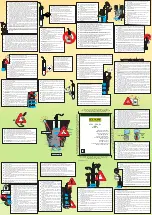
recommended is 10Nm (for 4” motors).
Attach the cable to the pump with the cable guard
and place the filter on the suction lantern.
Follow separate operating instructions (if available)
of the motor.
4. Electrical connection
Electrical connection must be carried
out only by a qualified electrician in
accordance with local regulations.
Follow safety standards.
The unit must be pro-
perly earthed (groun-
ded), also with a non-
metallic delivery pipe.
Make sure the frequency
and mains voltage cor-
respond with the name
plate data.
The
control panel
must
contain:
•
a device for disconnection
from the mains (switch)
with a contact separation
of at least 3 mm in all
poles;
•
an adequate motor pro-
tector for the current
indicated on the name-
plate;
•
a capacitor for the
SDM
single-phase pumps, in
accordance
with
the
data indicated on the
motors themselves.
For pumps with power rating above 11 kW, it is
advisable to provide the control panel with Y/ Δ
or impedance starting.
Install electrodes to protect the pump against dry
running.
4.1. Connection of cables
Feed cables have to be chosen on the basis of
power, distance, voltage drop and temperature.
For connection of cables in the well, use thermo-
shrinking insulation sheathes or other systems
used for submerged cables.
Before lowering the motor into the well, use appro-
priate instruments to measure continuity between
phases and perform an isolation test between each
single phase and the earth conductor.
4.2. Operation with frequency converter
Adjust the frequency converter so that the limiting
values of min. 30 Hz and max. 60 Hz will not be
exceeded.
The maximum running up time from 0 to 30 Hz
and running down time from 30 to 0 Hz for fre-
quency-converter operation is 1 second.
5. Starting
ATTENTION: never run the pump dry,
not even for a short trial run.
Start the pump with the gate valve regula-
ted to minimum aperture
and wait until the
delivery pipe is completely free of air.
With a three-phase motor make sure
the direction of rotation is correct.
For this purpose, with the gate valve at half-open
aperture position, check the pressure (with the
pressure gauge) or flow rate (sight check) after
starting. Switch off power, reverse the connections
of two phases on the control panel, re-start and
check the pressure or flow rate capacity again.
The correct direction of rotation will provide a con-
siderably greater and easily distinguishable pres-
sure and delivery capacity.
Make sure the sand residue present in the water
disappeares or is minimal.
Never start or run the pump when the gate
valve has been opened too widely.
Make sure the pump operates within its rated
limits of performance and that the rated absor-
bed current is not exceeded.
Otherwise, regulate the delivery gate valve or the
setting of any pressure switches.
ATTENTION: avoid long periods of operation
with closed discharge.
5.1. Generator supply
The switching sequence is of utmost importance.
If you do not apply this correctly, both motor and
generator may be damaged.
Therefore:
- AIways switch the generator on and off without load!
This means:
- Starting: aiways switch the generator ON first -
and the motor afterwards!
- Stopping: always switch the motor OFF first -
and the generator afterwards!
6. Maintenance
Under normal operating conditions with clean
water the pump will not require maintenance.
Absorbed current and head supplied by the pump
must be checked at regular intervals.
This procedure should be carried out frequently
when water contains considerable quantities of sand.
In the case of emergency systems, it is advisable to
operate the pumps once a month in order to avoid
the risk of blocking and to maintain and verify per-
fect efficiency.
Disconnect electrical power
before any servicing
operation.
Changes reserved.
4.93.128/3
BLACK 1
GREY
2
BROWN 3
GREEN/YELLOW
M
1
1
Electrical diagram
single-phase motors
5






































